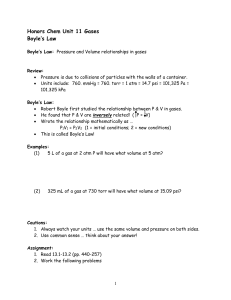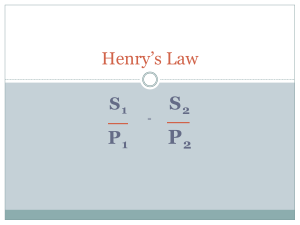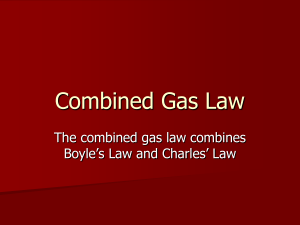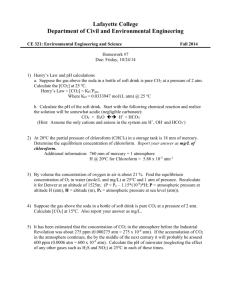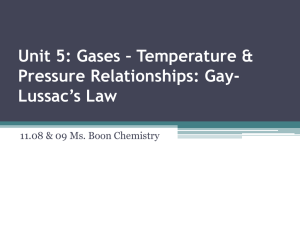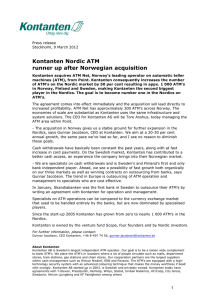Chapter 7 Gases
advertisement
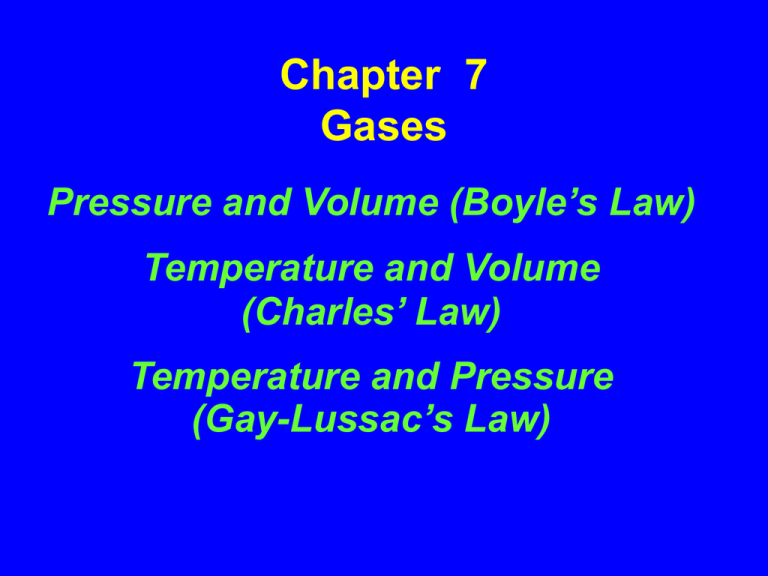
Chapter 7 Gases Pressure and Volume (Boyle’s Law) Temperature and Volume (Charles’ Law) Temperature and Pressure (Gay-Lussac’s Law) Pressure and Volume Experiment Pressure Volume (atm) (L) PxV (atm x L) 1 8.0 2.0 16 2 4.0 4.0 _____ 3 2.0 8.0 _____ 4 1.0 16 _____ Boyle's Law P x V = k (constant) when T remains constant P and V Changes P1 V1 P2 V2 Boyle's Law The pressure of a gas is inversely related to the volume when T does not change Then the PV product remains constant P1V1 = P2V2 P 1 V 1= 8.0 atm x 2.0 L = 16 atm L P 2 V 2= 4.0 atm x 4.0 L = 16 atm L PV Problem Freon-12, CCl2F2, is used in refrigeration systems. What is the new volume (L) of a 1.6 L sample of Freon gas initially at 50 mm Hg after its pressure is changed to 200 mm Hg at constant T? PV Calculation Prepare a data table DATA TABLE Initial conditions Final conditions P1 = 50 mm Hg P2 = 200 mm Hg V1 = 1.6 L V2 = ? ? Find New Volume (V2) Solve for V2: V2 = P1V2 = P2V2 V1 x P1 /P2 V2 = 1.6 L x 50 mm Hg = 200 mm Hg 0.4 L Learning Check GL1 A sample of nitrogen gas is 6.4 L at a pressure of 0.70 atm. What will the new volume be if the pressure is changed to 1.40 atm? (T constant) Explain. 1) 3.2 L 2) 6.4 L 3) 12.8 L Solution GL1 A sample of nitrogen gas is 6.4 L at a pressure of 0.70 atm. What will the new volume be if the pressure is changed to 1.40 atm? (T constant) 6.4 L x 0.70 atm = 3.2 L (1) 1.40 atm Volume must decrease to cause an increase in the pressure Learning Check GL2 A sample of helium gas has a volume of 12.0 L at 600. mm Hg. What new pressure is needed to change the volume to 36.0 L? (T constant) Explain. 1) 200. mmHg 2) 400. mmHg 3) 1200 mmHg Solution GL2 A sample of helium gas has a volume of 12.0 L at 600. mm Hg. What new pressure is needed to change the volume to 36.0 L? (T constant) Explain. 600. mm Hg x 12.0 L = 200. mmHg (1) 36.0 L Pressure decrease when volume increases. Charles’ Law V = 125 mL V = 250 mL T = 273 K T = 546 K Observe the V and T of the balloons. How does volume change with temperature? Charles’ Law: V and T At constant pressure, the volume of a gas is directly related to its absolute (K) temperature V1 = V2 T1 T2 Learning Check GL3 Use Charles’ Law to complete the statements below: 1. If final T is higher than initial T, final V is (greater, or less) than the initial V. 2. If final V is less than initial V, final T is (higher, or lower) than the initial T. Solution GL3 V1 T1 = V2 T2 1. If final T is higher than initial T, final V is (greater) than the initial V. 2. If final V is less than initial V, final T is (lower) than the initial T. V and T Problem A balloon has a volume of 785 mL on a Fall day when the temperature is 21°C. In the winter, the gas cools to 0°C. What is the new volume of the balloon? VT Calculation Complete the following setup: Initial conditions Final conditions V1 = 785 mL V2 = ? T1 = 21°C = 294 K T2 = 0°C = 273 K V2 = _______ mL x __ V1 K = _______ mL K Check your answer: If temperature decreases, V should decrease. Learning Check GL4 A sample of oxygen gas has a volume of 420 mL at a temperature of 18°C. What temperature (in °C) is needed to change the volume to 640 mL? 1) 443°C 2) 170°C 3) - 82°C Solution GL4 A sample of oxygen gas has a volume of 420 mL at a temperature of 18°C. What temperature (in °C) is needed to change the volume to 640 mL? 2) 170°C T2 = 291 K x 640 mL = 443 K 420 mL = 443 K - 273 K = 170°C Gay-Lussac’s Law: P and T The pressure exerted by a confined gas is directly related to the temperature (Kelvin) at constant volume. P (mm Hg) T (°C) 936 761 691 100 25 0 Learning Check GL5 Use Gay-Lussac’s law to complete the statements below: 1. When temperature decreases, the pressure of a gas (decreases or increases). 2. When temperature increases, the pressure of a gas (decreases or increases). Solution GL5 1. When temperature decreases, the pressure of a gas (decreases). 2. When temperature increases, the pressure of a gas (increases). PT Problem A gas has a pressure at 2.0 atm at 18°C. What will be the new pressure if the temperature rises to 62°C? (V constant) T = 18°C T = 62°C PT Calculation P1 = 2.0 atm P2 = ? ? T1 = 18°C + 273 = 291 K T2 = 62°C + 273 = 335 K What happens to P when T increases? P increases (directly related to T) P 2 = P 1 x T2 T1 P2 = 2.0 atm x K = K atm Learning Check GL6 Complete with 1) Increases 2) Decreases 3) Does not change A. Pressure _____, when V decreases B. When T decreases, V _____. C. Pressure _____ when V changes from 12.0 L to 24.0 L (constant n and T) D. Volume _____when T changes from 15.0 °C to 45.0°C (constant P and n) Solution GL6 A. Pressure 1) Increases, when V decreases B. When T decreases, V 2) Decreases C. Pressure 2) Decreases when V changes from 12.0 L to 24.0 L (constant n and T) D. Volume 1) Increases when T changes from 15.0 °C to 45.0°C (constant P and n)
